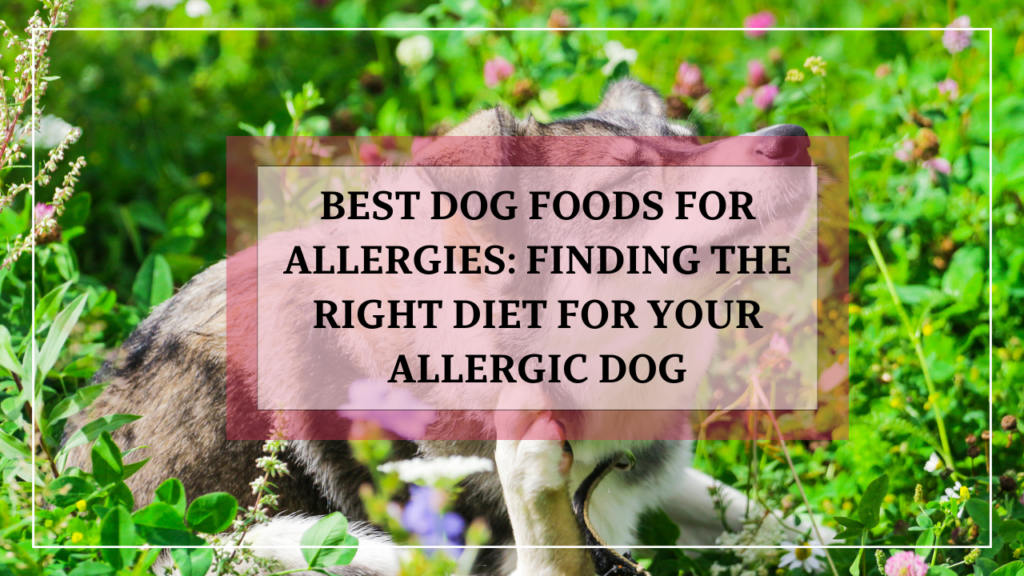We’re an affiliate. We hope you love the products we recommend! Just so you know, we may collect a share of sales or other compensation from the links on this page at no additional cost to you. Thank you if you use our links, we really appreciate it!
Dog allergies are a common yet challenging issue that many pet owners face. Just like humans, dogs can suffer from allergic reactions to a variety of substances, whether it’s something in their food or environmental triggers like pollen or dust. These allergies can lead to a range of symptoms, from itchy skin and digestive issues to respiratory problems.
As a responsible pet parent, understanding the causes and symptoms of dog allergies is crucial to managing them effectively. In this blog post, we will explore the different types of allergies in dogs, how to recognize the signs, and the role that diet can play in alleviating symptoms. You’ll also find valuable insights into choosing the right food for your allergic dog, along with expert tips on managing their overall health and environment to provide relief. Whether your dog is struggling with food sensitivities or environmental allergens, this guide will help you navigate the best solutions for their well-being.
Our Top Picks!
1. Blue Buffalo Basics
Best For: Dogs with mild to moderate food sensitivities or those needing a simplified diet. Its single protein, limited ingredient formula makes it ideal for dogs prone to allergic reactions but without severe conditions.
2. Wellness Core Grain-Free
Best For: Active dogs or those with grain and gluten sensitivities. The high protein content supports energy levels and lean muscle mass, making it great for dogs with specific grain allergies who need a protein-heavy diet.
3. Taste of the Wild High Prairie
Best For: Dogs with multiple food sensitivities. Its novel proteins like bison and venison, combined with a grain-free formula, make it excellent for dogs that react to more common proteins like chicken or beef.
Understanding Dog Allergies
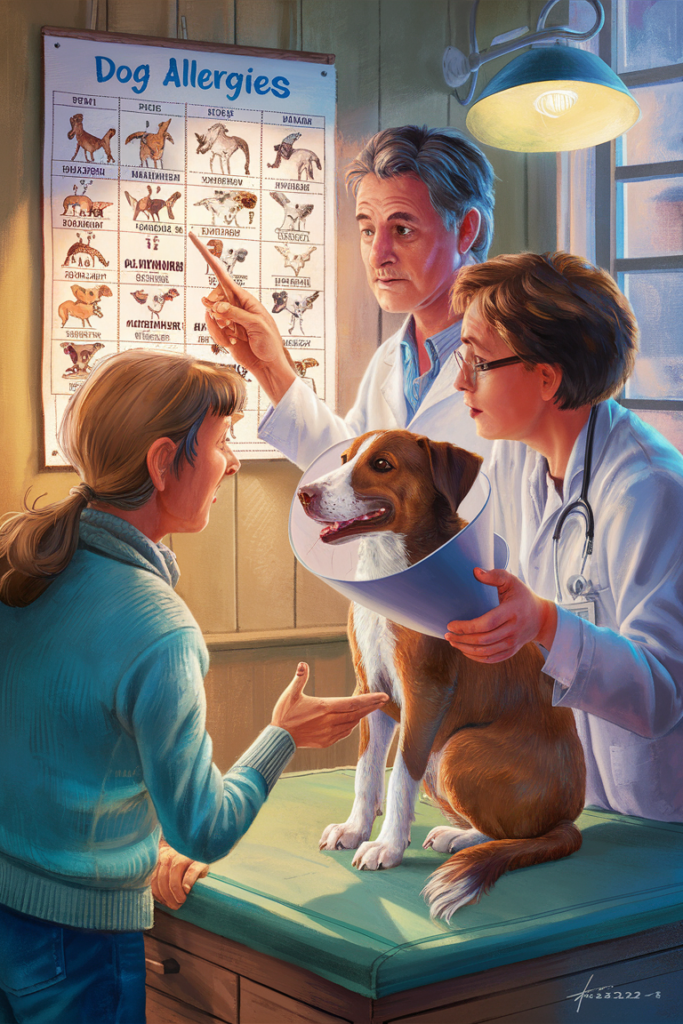
What Are Dog Allergies?
Dog allergies are immune system responses to certain substances that are typically harmless. These substances, known as allergens, can trigger a range of symptoms in dogs, from mild irritation to severe health issues. Allergies occur when a dog’s immune system mistakenly identifies a harmless substance as a threat and mounts an immune response against it.
Types of Allergies in Dogs:
- Food Allergies: Caused by specific ingredients in dog food, such as proteins or additives.
- Environmental Allergies: Triggered by pollen, dust mites, mold, or other environmental factors.
Common Allergies in Dogs
Food Allergies vs. Environmental Allergies
Food Allergies:
- Common Triggers: Beef, chicken, dairy, wheat, and soy.
- Symptoms: Vomiting, diarrhea, itching, and ear infections.
Environmental Allergies:
- Common Triggers: Pollen, dust mites, mold spores, and fleas.
- Symptoms: Itchy skin, sneezing, watery eyes, and respiratory issues.
Symptoms of Dog Allergies
Recognizing the symptoms of dog allergies is crucial for managing them effectively. Common signs include:
- Itchy Skin: Persistent scratching, biting, or licking of the skin.
- Digestive Issues: Vomiting, diarrhea, or changes in stool consistency.
- Ear Infections: Frequent ear scratching, head shaking, or ear discharge.
- Respiratory Problems: Coughing, sneezing, and nasal discharge.
Top 6 Recommended Brands for Dogs with Allergies
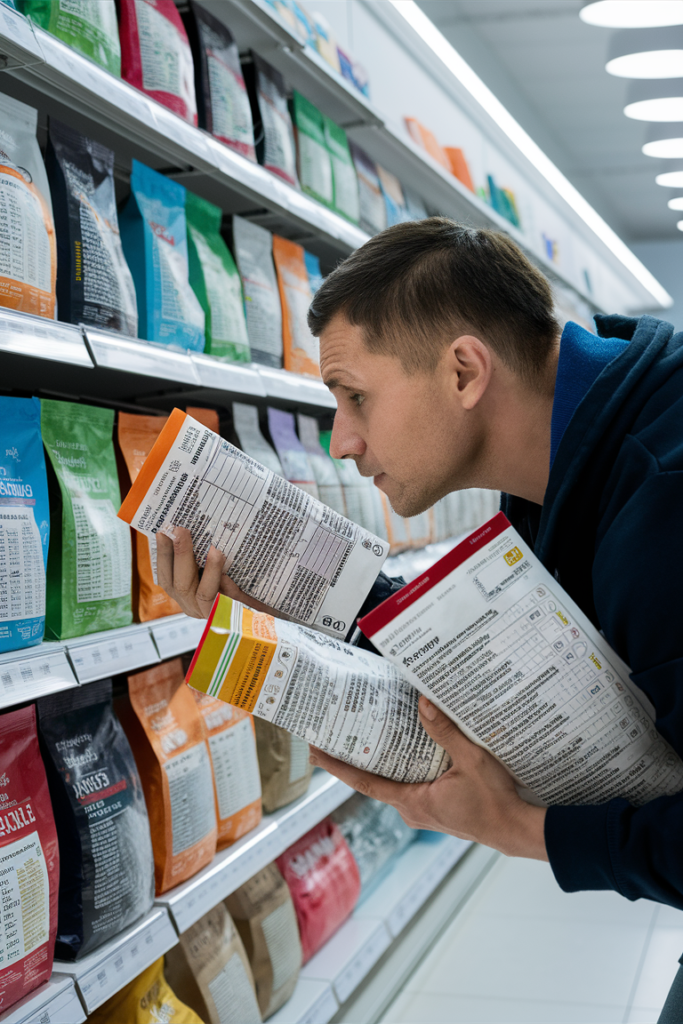
When dealing with dogs that have food sensitivities or allergies, choosing the right hypoallergenic food is critical. Such diets help minimize exposure to allergens while providing balanced nutrition. Below is a more detailed look at six recommended brands, their unique features, pros and cons, and a comparison of what each is best suited for.
1. Blue Buffalo Basics
Overview:
Blue Buffalo Basics is designed for dogs with food sensitivities. The limited ingredient recipes focus on minimizing exposure to potential allergens by using only essential, high-quality ingredients.
Key Features:
- Single Animal Protein: Options include turkey, salmon, and lamb, reducing the risk of exposure to multiple animal proteins that may cause allergies.
- Limited Carbohydrates: Easily digestible carbohydrates such as pumpkin and sweet potatoes are used instead of grains.
- Free from Common Allergens: Contains no corn, wheat, soy, dairy, or eggs—ingredients often linked to food allergies in dogs.
Pros:
- Reduces the likelihood of allergic reactions.
- Includes added vitamins, minerals, and antioxidants for overall health.
- Available in both dry and wet food options.
Cons:
- More expensive than standard dog foods.
- May not be suitable for dogs without significant food sensitivities due to the limited ingredients.
2. Wellness Core Grain-Free
Overview:
Wellness Core Grain-Free is formulated for high protein content without grains, making it an ideal choice for dogs with grain sensitivities or those needing a protein-focused diet.
Key Features:
- High-Protein Formula: Uses premium protein sources such as deboned chicken, turkey, and salmon.
- Grain-Free: Sweet potatoes, peas, and other grain alternatives provide carbohydrates.
- Enhanced with Probiotics: Helps maintain a healthy gut and supports digestion.
- Glucosamine and Chondroitin: Added to support joint health, especially important for larger breeds.
Pros:
- High-quality proteins, ideal for active dogs.
- Suitable for dogs with grain or gluten sensitivities.
- Contains omega fatty acids for skin and coat health.
Cons:
- Rich formula may lead to weight gain if portion sizes aren’t carefully monitored.
- May not be appropriate for less active dogs or those prone to obesity.
3. Taste of the Wild High Prairie
Overview:
Taste of the Wild High Prairie is a grain-free, protein-rich formula featuring novel proteins like bison and venison. It’s ideal for dogs that may have allergies to common proteins like chicken or beef.
Key Features:
- Novel Proteins: Utilizes unique protein sources such as bison and roasted venison, which are less likely to cause allergic reactions.
- Grain-Free: Carbohydrates come from sweet potatoes and peas instead of grains.
- Added Antioxidants: Contains fruits like blueberries and raspberries for immune system support.
- Probiotics: Includes species-specific probiotics to support gut health.
Pros:
- Excellent for dogs with multiple protein sensitivities.
- Provides high-quality proteins and natural ingredients.
- Good for maintaining overall immune and digestive health.
Cons:
- Higher fat content, which may not be suitable for all dogs, particularly sedentary ones.
- May be too rich for some dogs, leading to digestive issues if not transitioned properly.
4. Hill’s Prescription Diet Z/D
Overview:
Hill’s Prescription Diet Z/D is a specialized food designed for dogs with severe food allergies and intolerances. It features hydrolyzed proteins, much like Royal Canin, and is often recommended by veterinarians.
Key Features:
- Hydrolyzed Chicken Liver: This highly processed protein source reduces the risk of triggering an allergic reaction.
- Balanced Formula: Meets the nutritional needs of adult dogs while minimizing exposure to allergens.
- Skin and Coat Support: Contains omega-3 and omega-6 fatty acids for skin and coat health.
Pros:
- Ideal for dogs with diagnosed food allergies.
- Supports healthy digestion and skin.
- Highly digestible formula.
Cons:
- Requires a prescription.
- Expensive compared to over-the-counter alternatives.
5. Natural Balance L.I.D. (Limited Ingredient Diets)
Overview:
Natural Balance L.I.D. is designed for dogs with food sensitivities. It uses simple formulas with minimal ingredients to reduce the chance of adverse reactions.
Key Features:
- Limited Ingredient Formula: Focuses on one protein and one carbohydrate source to minimize allergens.
- Multiple Protein Options: Includes options like duck, lamb, or fish, paired with sweet potatoes or legumes.
- No Artificial Additives: Free from artificial colors, flavors, and preservatives.
Pros:
- Affordable compared to some other hypoallergenic options.
- Suitable for dogs with a range of sensitivities.
- Available in both wet and dry food.
Cons:
- Limited protein variety may not meet the needs of all dogs.
- Not specifically tailored for severe allergies.
Comparative Table of Recommended Hypoallergenic Brands
| Brand | Key Features | Pros | Cons |
|---|---|---|---|
| Blue Buffalo Basics | Single animal protein, grain-free | Reduces allergic reactions, good nutrition | Higher cost |
| Wellness Core | High-protein, grain-free | High-quality proteins, supports digestion | Rich formula, weight gain risk |
| Taste of the Wild | Novel proteins, grain-free | Good for multiple sensitivities, natural ingredients | Higher fat content |
| Hill’s Z/D | Hydrolyzed proteins, prescription required | Highly digestible, good for severe allergies | Expensive, vet prescription required |
| Natural Balance L.I.D. | Limited ingredients, multiple protein options | Affordable, free from artificial additives | Limited variety of proteins |
How Dog Food Can Impact Allergies
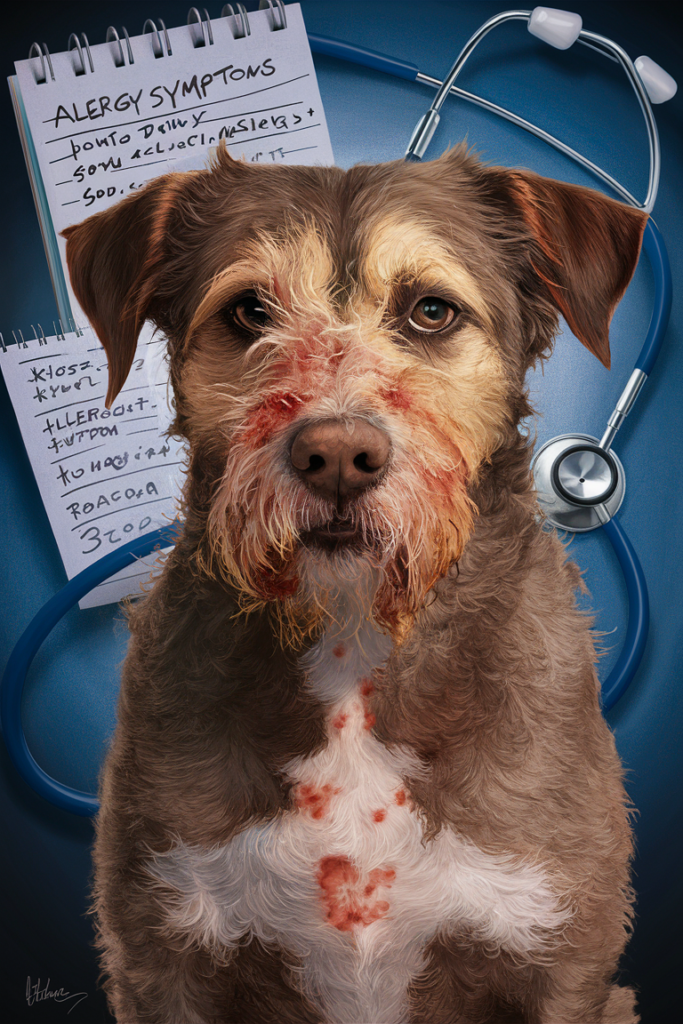
The Role of Diet in Managing Allergies
Diet plays a critical role in managing and alleviating dog allergies. By carefully selecting dog food that avoids common allergens and includes beneficial ingredients, you can significantly reduce allergy symptoms. A well-chosen diet can help:
- Reduce Inflammation: Foods with anti-inflammatory ingredients, such as omega fatty acids, can help soothe allergic reactions.
- Support Digestive Health: High-quality proteins and digestible carbohydrates can minimize gastrointestinal issues often associated with allergies.
- Promote Healthy Skin: Ingredients like fish oil and flaxseed can improve skin health and reduce itching and dryness.
Example: Dogs with food allergies might benefit from a diet rich in omega-3 and omega-6 fatty acids, which can help reduce inflammation and improve skin condition.
Ingredients to Avoid for Allergic Dogs
When selecting dog food for a dog with allergies, avoiding specific ingredients is crucial. Common allergens include:
- Grains: Wheat, corn, and soy are known to cause allergic reactions in many dogs.
- Dairy: Lactose intolerance is common in dogs, leading to digestive upset.
- Certain Proteins: Beef and chicken are frequent allergens.
Table: Common Dog Food Allergens
| Ingredient | Potential Reaction |
|---|---|
| Wheat | Digestive issues, itching |
| Corn | Skin irritations, vomiting |
| Soy | Allergic reactions, diarrhea |
| Dairy | Vomiting, diarrhea |
| Beef | Itchy skin, ear infections |
| Chicken | Itchy skin, gastrointestinal problems |
Benefits of Hypoallergenic Dog Food
Hypoallergenic dog food is formulated to minimize the risk of allergic reactions. Key benefits include:
- Reduced Allergen Exposure: Made with novel proteins and limited ingredients to avoid common allergens.
- Improved Digestibility: Easier on the digestive system, reducing the likelihood of gastrointestinal issues.
- Better Skin Health: Often enriched with ingredients that promote skin health and reduce itching.
Quote from Dr. Jane Smith, Veterinarian: “Hypoallergenic dog foods can be a game-changer for dogs with food allergies, providing relief and improving their overall quality of life.”
Types of Dog Food for Allergies

Limited Ingredient Diets (LID)
Limited Ingredient Diets (LID) are designed to reduce the number of ingredients in your dog’s food to minimize the chances of allergic reactions. This type of diet is beneficial for dogs with specific sensitivities because it:
- Reduces Exposure to Common Allergens: By limiting the number of ingredients, LID reduces the chance of including an allergen.
- Simplifies Identification of Triggers: Easier to identify which ingredient might be causing the allergy.
Key Features of LID:
- Single Protein Source: Often contains only one source of animal protein, such as lamb or venison.
- Single Carbohydrate Source: Includes a single type of carbohydrate, like sweet potatoes or peas.
Example Brand: Blue Buffalo Basics LID offers options with turkey and potato, aimed at reducing allergen exposure.
Grain-Free Dog Food
Grain-free dog food excludes grains like wheat, corn, and soy, which are common allergens for many dogs. This type of diet is beneficial because:
- Avoids Common Grain Allergens: Many dogs are sensitive to grains, which can cause digestive and skin issues.
- Includes Alternative Carbohydrates: Utilizes ingredients like sweet potatoes and peas, which are generally well-tolerated.
Pros and Cons of Grain-Free Diets:
| Pros | Cons |
|---|---|
| Reduces exposure to common allergens | May not be suitable for all dogs |
| Often includes high-quality proteins | Some grain-free options can be high in fat |
Example Brand: Wellness Core Grain-Free provides high protein content and uses alternative carbohydrates.
Novel Protein Diets
Novel protein diets use proteins that your dog has not been exposed to before, such as duck, venison, or rabbit. These diets are beneficial for:
- Reducing Allergic Reactions: New proteins are less likely to trigger an allergy if the dog has not been previously exposed.
- Improving Digestibility: Often easier on sensitive digestive systems.
Example Brand: Royal Canin Selected Protein offers options with novel proteins like rabbit or venison.
Prescription Diets
Prescription diets are formulated specifically for managing allergies and are available through veterinarians. These diets often include:
- Hydrolyzed Proteins: Proteins broken down into smaller components to reduce allergenicity.
- Specially Balanced Nutrients: Tailored to meet the nutritional needs of allergic dogs.
When to Consider Prescription Diets:
- When over-the-counter options do not alleviate symptoms.
- When a veterinarian recommends a specialized diet based on allergy testing.
Example Brand: Hill’s Prescription Diet z/d uses hydrolyzed proteins to minimize allergic reactions.
Quote from Dr. Lisa Johnson, Veterinary Nutritionist: “Prescription diets can offer relief for dogs with severe allergies that don’t respond to standard hypoallergenic foods.”
Top Ingredients to Look for in Allergy-Friendly Dog Food
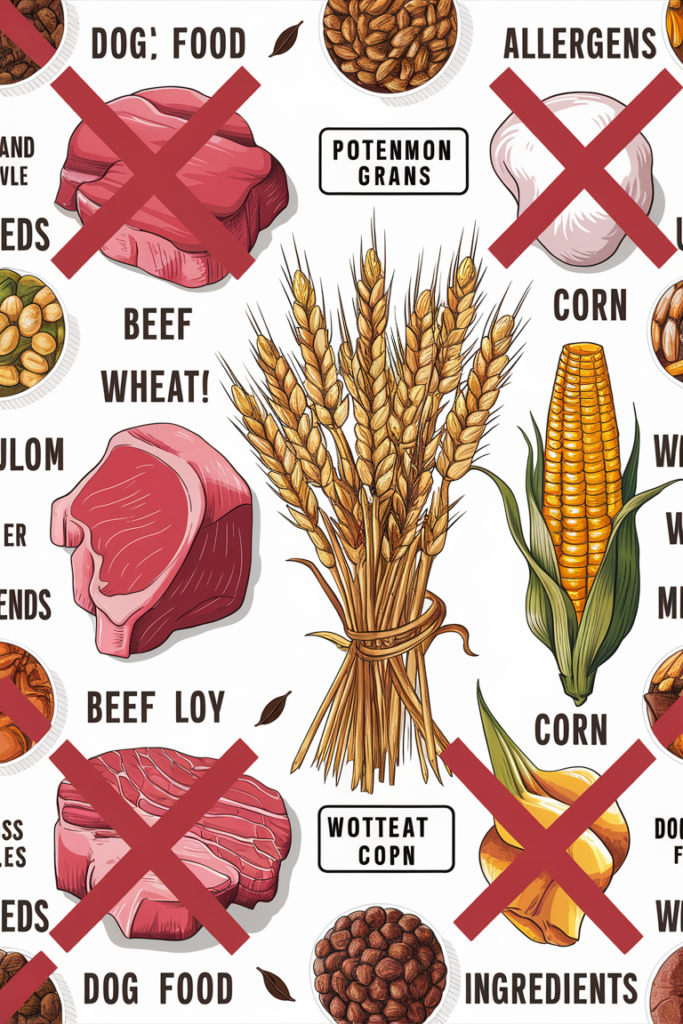
High-Quality Protein Sources
When choosing dog food for allergies, opting for high-quality protein sources is crucial. These proteins should be easily digestible and less likely to cause allergic reactions. Recommended protein sources include:
- Fish: Salmon and whitefish are excellent choices for their high omega-3 fatty acid content.
- Lamb: A novel protein for many dogs, making it less likely to trigger allergies.
- Venison: Another novel protein that is beneficial for dogs with food sensitivities.
Table: Benefits of Quality Protein Sources
| Protein Source | Benefits |
|---|---|
| Salmon | Rich in omega-3 fatty acids, supports skin health |
| Lamb | Novel protein, less likely to cause allergies |
| Venison | High-quality, easily digestible protein |
Example Brand: Orijen Original features free-run chicken and turkey, along with wild-caught fish, providing a variety of high-quality proteins.
Digestible Carbohydrates
Carbohydrates in dog food should be easy for dogs to digest and less likely to cause allergic reactions. Preferred carbohydrate sources include:
- Sweet Potatoes: Rich in vitamins and fiber, easily digestible.
- Peas: Provide a good source of fiber and protein.
- Pumpkin: Supports digestive health and is gentle on the stomach.
Chart: Comparison of Digestible Carbohydrates
| Carbohydrate Source | Nutritional Benefits |
|---|---|
| Sweet Potatoes | High in vitamins A and C, fiber |
| Peas | Good source of protein and fiber |
| Pumpkin | Helps with digestion and supports gut health |
Added Supplements for Allergies
Certain supplements can help manage and alleviate allergy symptoms. Look for dog foods that include:
- Omega Fatty Acids: Promote healthy skin and reduce inflammation.
- Probiotics: Support digestive health and boost the immune system.
- Glucosamine: Helps maintain joint health, which can be beneficial for dogs with allergies.
How to Choose the Best Dog Food for Allergies
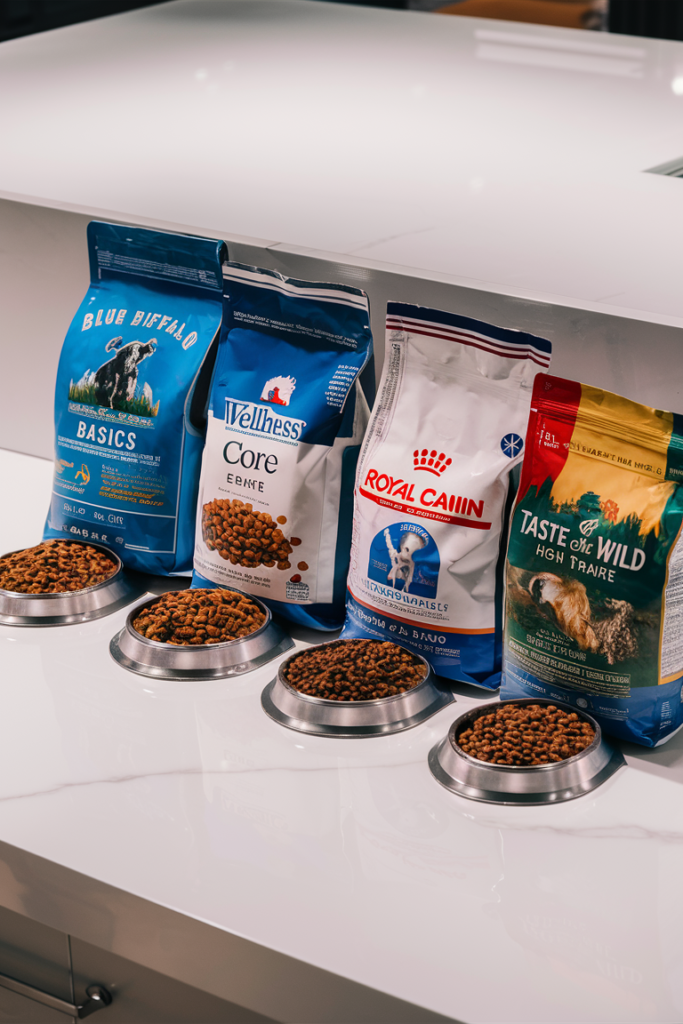
Consult with Your Veterinarian
Choosing the best dog food for allergies often begins with a consultation with your veterinarian. They can provide valuable insights into:
- Diagnosis: Identifying whether your dog’s symptoms are due to food allergies, environmental factors, or a combination of both.
- Recommended Diets: Suggesting specific types of food based on your dog’s health needs and allergy profile.
- Ongoing Monitoring: Advising on how to monitor your dog’s response to new food and make necessary adjustments.
Quote from Dr. Sarah Thompson, Veterinarian: “Consulting with a veterinarian ensures that you are making an informed choice that addresses your dog’s specific health needs and allergy triggers.”
Reading Labels and Understanding Ingredients
When selecting dog food for allergies, reading labels carefully is essential. Here’s what to look for:
- Ingredient List: Ensure the primary ingredients are high-quality and do not include common allergens like beef or wheat.
- Guaranteed Analysis: Check the nutritional content to ensure it meets your dog’s dietary needs.
- Additives and Preservatives: Avoid foods with artificial colors, flavors, or preservatives, which can aggravate allergies.
Table: Key Points to Check on Dog Food Labels
| Label Component | What to Look For |
|---|---|
| Ingredients List | High-quality, limited ingredients |
| Guaranteed Analysis | Balanced nutrition that fits your dog’s needs |
| Additives/Preservatives | No artificial additives or preservatives |
Trial and Error: Finding the Right Food
Finding the best dog food for allergies may require some experimentation. Here’s how to approach it:
- Introduce New Food Gradually: Mix the new food with the current food over a period of 7-10 days to avoid digestive upset.
- Monitor Symptoms: Keep track of any changes in symptoms, such as reduced itching or improved digestion.
- Adjust as Needed: If symptoms persist or worsen, consult your veterinarian to reassess and try a different food.
Chart: Steps for Transitioning to New Dog Food
| Step | Action |
|---|---|
| Day 1-3 | Mix 25% of new food with 75% old food |
| Day 4-6 | Mix 50% of new food with 50% old food |
| Day 7-10 | Mix 75% of new food with 25% old food |
| Day 11 onward | Feed 100% of new food |
Tips for Managing Your Dog’s Allergies Beyond Food

1. Regular Vet Check-Ups
Regular veterinary check-ups are crucial for managing your dog’s allergies effectively. These visits can help:
- Monitor Allergy Symptoms: Track any changes in symptoms and adjust treatment or diet as necessary.
- Update Allergy Testing: Conduct tests to identify new or evolving allergies.
- Adjust Treatments: Modify treatment plans based on your dog’s response to food or other interventions.
Quote from Dr. Mark Robinson, Veterinarian: “Consistent vet visits help ensure that any changes in your dog’s condition are promptly addressed and managed.”
2. Maintaining a Clean Environment
Keeping your dog’s environment clean can help reduce allergen exposure. Consider these practices:
- Regular Cleaning: Vacuum frequently and wash your dog’s bedding to remove dust mites and other potential allergens.
- Use Air Purifiers: Install air purifiers with HEPA filters to reduce airborne allergens.
- Bathing and Grooming: Regular baths with hypoallergenic shampoos can help remove allergens from your dog’s skin and coat.
Checklist: Environmental Allergens
- Vacuum and clean floors and furniture regularly
- Wash dog bedding weekly
- Use air purifiers
- Bathe your dog with hypoallergenic products
3. Managing Fleas and Parasites
Fleas and other parasites can exacerbate allergy symptoms. To manage these issues:
- Use Flea Preventatives: Apply vet-recommended flea preventatives to keep your dog free from fleas and ticks.
- Regular Inspections: Check your dog’s coat and skin for signs of fleas or other parasites.
Example Flea Prevention Products:
- Frontline Plus: Provides effective flea and tick control.
- Advantage II: Offers fast-acting flea control.
4. Monitor and Adjust Diet
Even after finding the right food, continuous monitoring is essential. Follow these steps:
- Observe Changes: Keep track of your dog’s reaction to the new diet, noting any improvements or adverse effects.
- Adjust as Needed: If symptoms persist, consult your vet to adjust the diet or try a different formula.
Chart: Monitoring Diet Changes
| Observation | Action |
|---|---|
| Improved Symptoms | Continue current diet |
| No Change | Consult vet for further advice |
| Worsening Symptoms | Try a different food or consult vet |
5. Providing Appropriate Supplements
In addition to diet, supplements can support your dog’s overall health and help manage allergies. Consider:
- Omega-3 Fatty Acids: For reducing inflammation and supporting skin health.
- Probiotics: To enhance digestive health and immune function.
Supplement Recommendations:
- Nordic Naturals Omega-3 Pet: Supports skin and coat health.
- Purina Pro Plan Veterinary Diets FortiFlora: A probiotic supplement that aids digestion and boosts immunity.
FAQs
1. What is the best dog food for allergies?
The best dog food for allergies depends on your dog’s specific needs and triggers. Generally, high-quality brands with limited ingredients, novel proteins, and grain-free options are recommended. Some top choices include:
- Blue Buffalo Basics: Offers a limited ingredient diet with single animal proteins.
- Wellness Core Grain-Free: Provides high protein content and avoids grains.
- Royal Canin Hypoallergenic: Features hydrolyzed proteins designed for severe allergies.
2. How do I know if my dog has food allergies?
Food allergies in dogs often manifest as:
- Skin Issues: Itching, redness, or rashes.
- Digestive Problems: Vomiting, diarrhea, or excessive gas.
- Ear Infections: Frequent ear infections or inflammation.
Consulting with a veterinarian and conducting an elimination diet or allergy testing can help diagnose food allergies accurately.
3. How should I transition my dog to a new allergy-friendly food?
To transition your dog to a new food:
- Start Slowly: Mix the new food with your dog’s current food in gradually increasing amounts.
- Observe Reactions: Monitor your dog for any adverse reactions or improvements in allergy symptoms.
- Complete the Transition: Continue this process over 7-10 days to avoid digestive upset.
Chart: Transitioning Dog Food
| Day | Action |
|---|---|
| Days 1-3 | Mix 25% new food with 75% old food |
| Days 4-6 | Mix 50% new food with 50% old food |
| Days 7-10 | Mix 75% new food with 25% old food |
| Day 11 onward | Feed 100% new food |
4. Can I give my dog homemade food for allergies?
Yes, homemade food can be a good option for dogs with allergies, but it’s important to ensure it is nutritionally balanced. Consult with a veterinarian or a veterinary nutritionist to create a diet plan that meets all of your dog’s nutritional needs while avoiding allergens.
5. What are some common allergens in dog food?
Common allergens in dog food include:
- Beef: A frequent cause of food allergies.
- Wheat: Often used as a filler and can cause allergic reactions.
- Corn: Another common allergen found in many commercial dog foods.
- Soy: Can cause digestive and allergic issues in some dogs.
6. How can I tell if a dog food brand is trustworthy?
To determine if a dog food brand is trustworthy:
- Check Ingredients: Look for high-quality, recognizable ingredients with no fillers or artificial additives.
- Read Reviews: Look for feedback from other pet owners and check ratings on reputable websites.
- Consult Your Vet: Seek recommendations from your veterinarian who understands your dog’s specific needs.
7. Are there any specific dog foods recommended for puppies with allergies?
Yes, there are allergy-friendly dog foods formulated for puppies. These typically include:
- Hill’s Science Diet Puppy Sensitive Stomach & Skin: Designed to be gentle on young dogs with allergies.
- Purina Pro Plan Puppy Sensitive Skin & Stomach: Includes easily digestible ingredients and is free from common allergens.

